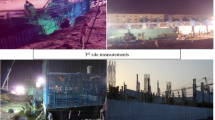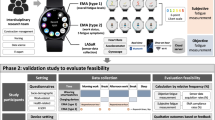Abstract
A variety of research has highlighted the importance of improving safety in the construction industry. Due to the attributes of construction activities (e.g., inappropriate shiftwork and schedules) and sites (e.g., darkness, narrowness), human errors frequently cause construction accidents, especially when construction workers suffer from mental and/or physical fatigue. To address this problem, this study proposes an approach based on Physiological Status Monitoring (PSM). By detecting brain wave rhythms and Heart Rate Variability (HRV) of workers, the proposed approach could analyze fatigue levels. After identifying risks of fatigue, the proposed approach notifies the fatigued workers as well as transfers relevant statistics to construction managers. The managers, therefore, are able to supervise their workers in real time. Given the results of on-site tests, construction safety management is enhanced, while the construction accidents caused by mentally and/or physically fatigued workers are circumvented as quickly as possible. Consequently, this study is a useful reference for similar applications in many countries.
Similar content being viewed by others
References
Achten, J. and Jeukendrup, A. E. (2003). “Heart rate monitoring.” Sports medicine, Vol. 33, No. 7, pp. 517–538, 10.2165/00007256-200333070-00004.
Bolanos, M., Nazeran, H., and Haltiwanger, E. (2006). “Comparison of heart rate variability signal features derived from electrocardiography and photoplethysmography in healthy individuals.” In: Proceedings of the 28th EMBS Annual International Conference, United States, 10.1109/IEMBS.2006.4398399.
Cheng, C. W., Leu, S. S., Cheng, Y. M., Wu, T. C., and Lin, C. C. (2012). “Applying data mining techniques to explore factors contributing to occupational injuries in Taiwan’s construction industry.” Accident Analysis and Prevention, Vol. 48, pp. 214–222, DOI: 10.1016/j.aap. 2011.04.014.
Cheng, T., Migliaccio, G. C., Teizer, J., and Gatti, U. C. (2013). “Data fusion of real-time location sensing and physiological status monitoring for ergonomics analysis of construction workers.” Journal of Computing in Civil Engineering, Vol. 27, No. 3, pp. 320–335, DOI: 10.1061/(ASCE)CP.1943-5487.0000222.
Chi, S., Han, S., Kim, D. Y., and Shin, Y. (2015). “Accident risk identification and its impact analyses for strategic construction safety management.” Journal of Civil Engineering and Management, Vol. 21, No. 4, pp. 524–538, DOI: 10.3846/13923730.2014.890662.
Costin, A., Pradhananga, N., and Teizer, J. (2012). “Leveraging passive RFID technology for construction resource field mobility and status monitoring in a high-rise renovation project.” Automation in Construction, Vol. 24, pp. 1–15, DOI: 10.1016/j.autcon.2012.02.015.
Fang, D., Jiang, Z., Zhang, M., and Wang, H. (2015). “An experimental method to study the effect of fatigue on construction workers’ safety performance.” Safety Science, Vol. 73, pp. 80–91, DOI: 10.1016/j.ssci.2014.11.019.
Garmin (2016). Specification of Fenix 3 HR, Taiwan.
Garrett, J. W. and Teizer, J. (2009). “Human factors analysis classification system relating to human error awareness taxonomy in construction safety.” Journal of Construction Engineering and Management, Vol. 135, No. 8, pp. 754–763, DOI: 10.1061/(ASCE)CO.1943-7862.0000034.
Gheisari, M., Irizarry, J., and Walker, B. (2014). “UAS4SAFETY: The potential of unmanned aerial systems for construction safety applications.” In: Construction Research Congress 2014, pp. 1801–1810, United States, DOI: 10.1061/9780784413517.184.
Grandjean, E. (1979). “Fatigue in industry.” British Journal of Industrial Medicine, Vol. 36, No. 3, pp. 175–186.
Hsiao, H. and Simeonov, P. (2001). “Preventing falls from roofs: A critical review.” Ergonomics, Vol. 44, No. 5, pp. 537–561, DOI: 10.1080/00140130110034480.
ithlete (2016). Monitoring Heart Rate Variability (HRV) is so much more valuable than just monitoring heart rate, United Kingdom.
Ju, O. Y., Il, J. T., Meiling, L., and Hee, L. Y. (2012). “A study on fatigue measurement of operators for human error prevention in NPPs.” In: Transactions of the Korean Nuclear Society Autumn Meeting, Gyeongju, Korea.
Kelm, A., Laußata, L., Meins-Becker, A., Platz, D., Khazaee, M. J., Costin, A. M., Helmus, M., and Teizer, J. (2013). “Mobile passive Radio Frequency Identification (RFID) portal for automated and rapid control of Personal Protective Equipment (PPE) on construction sites.” Automation in Construction, Vol. 36, pp. 38–52, DOI: 10.1016/j.autcon.2013.08.009.
Lai, K. C. and Kang, S. C. (2009). “Collision detection strategies for virtual construction simulation.” Automation in construction, Vol. 18, pp. 724–736, 10.1016/j.autcon.2009.02.006.
Lal, S. K. L. and Craig, A. (2001). “A critical review of the psychophysiology of driver fatigue.” Biological psychology, Vol. 55, pp. 173–194, DOI: 10.1016/S0301-0511(00)00085-5.
Langford, D., Rowlinson, S., and Sawacha, E. (2000). “Safety behaviour and safety management: Its influence on the attitudes of workers in the UK construction industry.” Engineering, Construction and Architectural Management, Vol. 7, No. 2, pp. 133–140, DOI: 10.1108/eb021138.
Ling, F. Y. Y., Liu, M., and Woo, Y. C. (2009). “Construction fatalities in Singapore.” International Journal of Project Management, Vol. 27, No. 7, pp. 717–726, DOI: 10.1016/j.ijproman.2008.11.002.
Liu, N., Huang, B., and Chandramouli, M. (2006). “Optimal siting of fire stations using GIS and ANT algorithm.” Journal of Computing in Civil Engineering, Vol. 20, No. 5, pp. 361–369, DOI: 10.1061/(ASCE)0887-3801(2006)20:5(361).
Makivic, B., Nikic, M. D., and Willis, M. S. (2013). “Heart Rate Variability (HRV) as a tool for diagnostic and monitoring performance in sport and physical activities.” Journal of Exercise Physiology, Vol. 16, No. 3, pp. 103–131.
NeuroSky (2016). Experience today’s most affordable EEG headsets, NeuroSky, United States.
Park, M. W., Koch, C., and Brilakis, I. (2012). “Three-dimensional tracking of construction resources using an on-site camera system.” Journal of Computing in Civil Engineering, Vol. 26, No. 4, pp. 541–549, DOI: 10.1061/(ASCE)CP.1943-5487.0000168.
Saito, K. (1999). “Measurement of fatigue in industries.” Industrial health, Vol. 37, No. 2, pp. 134–142, DOI: 10.2486/indhealth.37.134.
Seo, H. C., Lee, Y. S., Kim, J. J., and Jee, N. Y. (2015). “Analyzing safety behaviors of temporary construction workers using structural equation modeling.” Safety Science, Vol. 77, pp. 160–168, DOI: 10.1016/j.ssci.2015.03.010.
Tadokoro, S., Murphy, R., Stover, S., Brack, W., Konyo, M., Nishimura, T., and Tanimoto, O. (2009). “Application of active scope camera to forensic investigation of construction accident.” In: IEEE Workshop on Advanced Robotics and its Social Impacts, Japan, DOI: 10.1109/ARSO.2009.5587076.
Trejo, L. J., Kubitz, K., Rosipal, R., Kochavi, R. L., and Montgomery, L. D. (2015). “EEG-based estimation and classification of mental fatigue.” Psychology, Vol. 6, pp. 572–589, DOI: 10.4236/psych.2015.65055.
Tsai, M. K. (2014[1]). “Streamlining information representation during construction accidents.” KSCE Journal of Civil Engineering, Vol. 18, No. 7, pp. 1945–1954, DOI: 10.1007/s12205-014-0240-9.
Tsai, M. K. (2014[2]). “Automatically determining accidental falls in field surveying: A case study of integrating accelerometer determination and image recognition.” Safety Science, Vol. 66, pp. 19–26, DOI: 10.1016/j.ssci.2014.01.012.
Yu, Y. H., Yeh, C. H., Lee, T. T., Chen, P. Y., and Shiau, Y. H. (2014). “Chip-based real-time gesture tracking for construction robot’s guidance.” In: ISARC Proceedings of the International Symposium on Automation and Robotics in Construction, pp. 1–8, Australia.
Zhang, S., Teizer, J., Lee, J. K., Eastman, C. M., and Venugopal, M. (2013). “Building Information Modeling (BIM) and safety: Automatic safety checking of construction models and schedules.” Automation in Construction, Vol. 29, pp. 183–195, DOI: 10.1016/j.autcon.2012.05.006.
Author information
Authors and Affiliations
Corresponding author
Rights and permissions
About this article
Cite this article
Tsai, MK. Applying physiological status monitoring in improving construction safety management. KSCE J Civ Eng 21, 2061–2066 (2017). https://doi.org/10.1007/s12205-016-0980-9
Received:
Revised:
Accepted:
Published:
Issue Date:
DOI: https://doi.org/10.1007/s12205-016-0980-9




